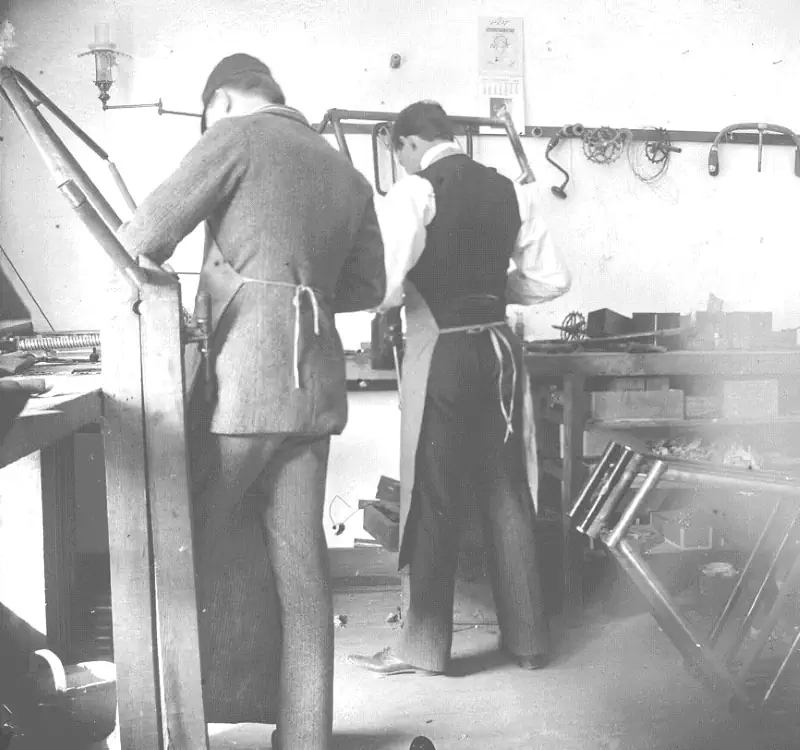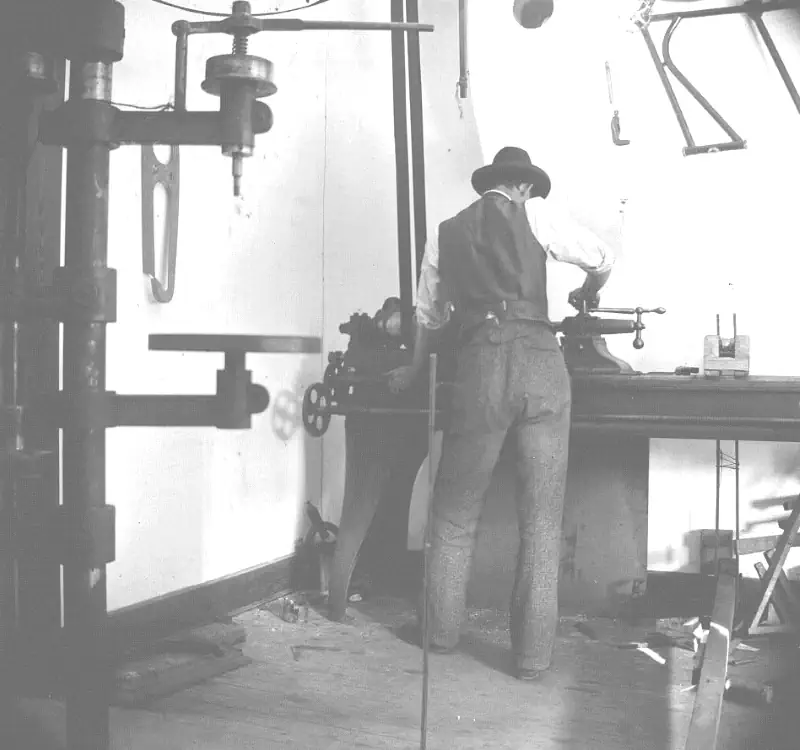The Wright Brothers, the American aviation pioneers who invented, built, and flew the first successful motor-operated airplane, have opened a bicycle rental and repair shop in Dayton, Ohio in 1893.
The bicycle craze in America began in 1887 with the introduction from England of the safety bicycle. The safety, with its two wheels of equal size, was easier to ride than the traditional high-wheel bicycles which were prone to accidents. It made the freedom of cycling accessible to a much wider market. At the height of the bicycle boom in the 1890s, more than 300 companies were producing over a million bicycles per year.
The Wright Brothers’ (Orville, August 19, 1871 – January 30, 1948, and Wilbur, April 16, 1867 – May 30, 1912) best-known pre-aeronautical occupation was bicycle repair and manufacture.
The bicycle business of the Wright brothers, the Wright Cycle Company (originally the Wright Cycle Exchange) successively occupied six different locations in Dayton, Ohio. This provided them with an adequate and enjoyable living, an upstanding reputation in the local business community, and an outlet for their mechanical interests.
Wright brothers: skillful cyclists
The Wright brothers purchased bicycles in the spring of 1892. Wilbur preferred long country rides, while Orville enjoyed racing and considered himself a “scorcher” on the track. Surprisingly, no photographs exist of Wilbur or Orville on or with a bicycle.
Their growing local reputation as skillful cyclists and mechanics led to many requests from friends to fix their bicycles. In 1893 they capitalized on the situation and opened a small rental and repair shop.
With their newspapers defunct and Ed Sines handling most of the day-to-day tasks of the printing shop, the brothers were in search of a new challenge. Bicycles furnished it. Knowledge and experience with bicycles proved valuable to the Wrights’ development of a successful airplane.


Van Cleve brand
In 1896 they began manufacturing and selling bicycles of their own design, the Van Cleve, named after an early settler of Dayton, and St. Clair, named after a territorial governor. They invented the self-oiling hub and devised the innovation of machining the crankarm and pedal on the left side with left-hand threads to prevent the pedal from coming unscrewed while cycling.
During their peak production years of 1896 to 1900, Wilbur and Orville built about 300 bicycles and earned $2,000 to 3,000 per year.
Their top-of-the-line model, the Van Cleve sold for $65. The less expensive St. Clair sold for $42.50.
They moved the Wright Cycle Co. for the last time in 1897, to 1127 West Third Street. Here they built all their experimental aircraft, including the first powered airplane in 1903.
Later, Henry Ford purchased the shop, along with the Wrights’ house, and moved them in 1937 to his Greenfield Village complex in Dearborn, Michigan, where they are open to the public.
Today, only five bicycles manufactured by the Wright brothers are known to exist.
From bicycles to the first airplane
In designing their airplane, the Wright brothers drew upon a number of bicycle concepts:
- The central importance of balance and control.
- The need for strong but lightweight tubes.
- The chain-and-sprocket transmission system for propulsion.
- Concerns regarding wind resistance and aerodynamic shape of the operator.
Between 1899 and 1905, the Wright brothers conducted a program of aeronautical research and experimentation that led to the first successful powered airplane in 1903 and a refined, practical flying machine two years later. All successful airplanes since then have incorporated the basic design elements of the 1903 Wright Flyer.
The genius of Wilbur and Orville lay not only in the singular act of getting a flying machine into the air but also in the approach they evolved and employed to create the technology of flight.
Their method of evaluating data gathered by testing an aircraft in flight, then refining the design based on those results, remains an essential tool in aerospace research and development.
Wright brothers gained the mechanical skills essential for their success by working for years in their shop with printing presses, bicycles, motors, and other machinery. Their work with bicycles in particular influenced their belief that an unstable vehicle like a flying machine could be controlled and balanced with practice. From 1900 until their first powered flights in late 1903, they conducted extensive glider tests that also developed their skills as pilots. Their bicycle shop employee Charlie Taylor became an important part of the team, building their first airplane engine in close collaboration with the brothers.
Sources
- Wright Brothers’ Bicycle Shop on the Smithsonian National Air and Space Museum website
- Wright Brothers on Wikipedia
- Wright Bicycles on the Wright Brothers website
- Wright Cycle Company on Wikipedia
- BikesOnline Carlsbad: Your Premier Cycling Destination in San Diego County - June 15, 2025
- Top 19 fastest Paris-Roubaix editions - April 14, 2025
- Fausto Coppi in Africa [A Very Rare Photo] - January 4, 2025
